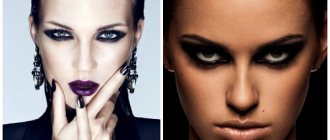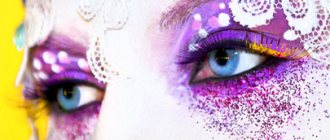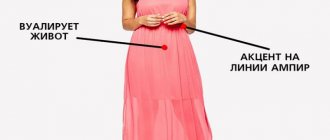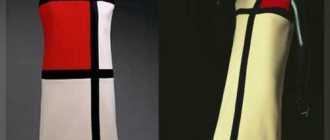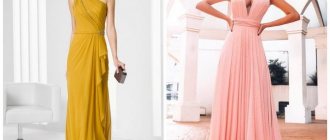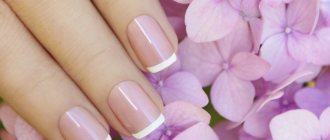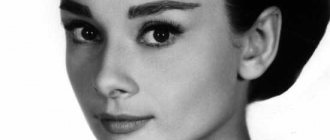Hairstyles in the dude style are still popular today. The dude style is a bright and different image from others; it attracts attention with a stylish and exciting appearance, manifested both in clothes, makeup, and hairstyle, from which it is impossible to take your eyes off. Such styling is distinguished by large backcombs, intricate bangs, curls, and an abundance of decorative elements.
Hairstyles in the style of a 60s dude - who suits them
There are a lot of dude-style hairstyles, so everyone can choose the right look.
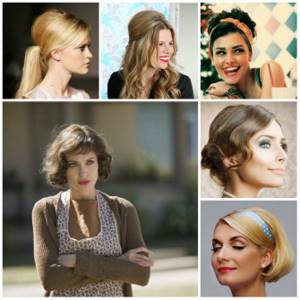
There are no restrictions on hair structure and face type, the only main thing is the desire to get a “stylish” look.

The only thing is that shy individuals may not feel very comfortable, due to the fact that the image will attract attention in any case.
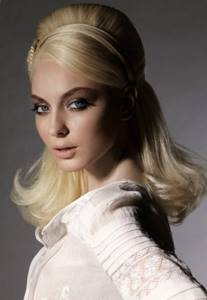
In order for the dude's image to be complete, it must be complemented with special accessories: large and bright beads and bracelets, belts, bright scarves, large earrings.
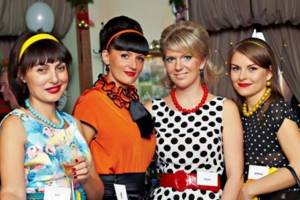
An integral attribute is the bag; it is also usually quite bright in color. Dresses are fluffy at the bottom and narrow at the top.
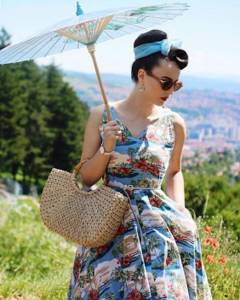
Of course, now girls can use this style of styling with modern things, if the hairstyle provides for this and is not created for a specific thematic image.

How to make a dude's hairstyle with your own hands will be described below, described step by step and presented in the photo.
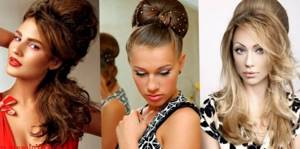
New in blogs
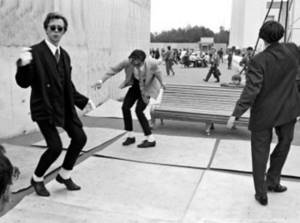
Hipsters as a youth subculture arose in the USSR and became widespread in large Soviet cities from the late 1940s to the early 1960s, having a predominantly American way of life as a standard.
[more]
They were distinguished by their deliberate apoliticality, cynicism in their judgments, and a negative attitude towards some norms of Soviet morality. But the main thing is that they stood out with their bright clothes and increased interest in music and dance from abroad.
Official fashion suggested wearing something like this
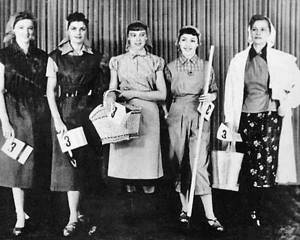
In reality, people mostly dressed like this
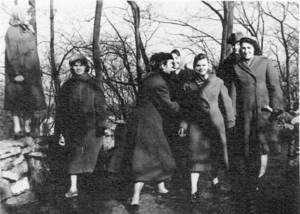
But young people wanted to look like this
It was important for hipsters to stand out not only with the help of clothing or lifestyle, but also with the help of a special language, or rather, jargon. This slang was partially adopted by the hipsters from jazz players. Here are some words and expressions adopted in the dude language and then partially spread beyond its borders:
Broadway (or Broad) is usually the central street of the city, which served as a meeting place for dudes. In Moscow, “Broadway” was Gorky Street (now Tverskaya). in Leningrad - Nevsky Prospekt, in Kazan - Bauman Street, in Nizhny Novgorod - Bolshaya Pokrovskaya, in Baku - Torgovaya Street, in Tashkent - Karl Marx Street (now Sayyolgokh), in Odessa - Deribasovskaya Street, in Alma-Ata - a park along the street Kalinin (now Kabanbai batyr). Every city or even urban area had its own “Broadways”.
The dude is a trusted young man who was invited to the “process” (narrow party) in the “hut”.
Chuvikha (chuva) - girl.
To slander - to walk, float.
To throw a break is to walk with the goal of “seeing people and showing yourself off.” As a rule, it sounded like “throw a break along the Broad.”
Chucha is the song "Train to Chattanooga" ("Chattanooga Choo Choo...") from the cult film "Sun Valley Serenade".
Sovparshiv - distorted from “SovPoshiv”, domestic light industry products.
Dynamo, Dynamo-machine - taxi.
Shoes, shuznya (English shoes - shoes) - dude boots with high soles. Usually it could be purchased exclusively from black marketeers. The Soviet analogue of “shoes” - the so-called “semolina porridge” - a thick piece of plastic or rubber was glued to the shape of Soviet boots.
Hut - apartment.
Phaser (English father - father) - father of the dudes
Look (English look - look, look) - look
Rednecks - representatives of the “gray mass”
Borukha (barukha) is a girl from the hipster class.
Drink (English drink - drink an alcoholic drink, get drunk) - drink
Jacket (English jacket - jacket, jacket) - jacket
Manyushki (eng. money - money) - money
Old (English old - old) - old
Ruddy loaves are ordinary girls, not dudes, participating in parties
Socks (eng. socks - stockings, socks) - socks. Socks were always worn in bright colors; they had to be visible from under the trouser leg.
Style (English style - style, manner) - dance in "style", imitating "imported" dances or simply inventing movements
Taek (English tie - knot, bow, tie) - tie
Truzer, Trauser, trauzers (English trousers - trousers) - trousers
Trench coat (eng. trenchcoat - overcoat) - cloak
Hatok (English hat - headdress) - hat
The films “Sun Valley Serenade”, “George from Dinky Jazz”, “Tarzan”, “The Girl of My Dreams”, “A Soldier’s Fate”, films with the participation of Deanna Durbin, have become cult films for dudes.
German postcard featuring Victor Staal and Marika Rökk. The sweater “with deer” on Staal was popular among dudes
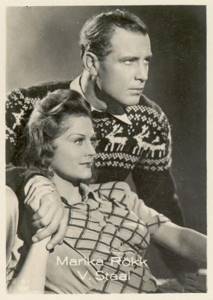
The word has come into use since 1949 after the publication in the magazine “Crocodile” (No. 7, dated March 10) of D. G. Belyaev’s feuilleton “Hipsters,” published under the heading “Types that are a thing of the past.”
The feuilleton described a school evening where a vain, ignorant, stupid young man appears, ridiculously dressed “in a foreign style,” and proud of his colorful outfit and skills in foreign dances. And all these skills, according to the feuilletonist, evoke laughter and disgusted pity among the other students.
Description of the dudes from D. G. Belyaev’s feuilleton: “A young man appeared at the door of the hall. He had an amazingly absurd appearance: the back of the jacket was bright orange, and the sleeves and hems were green; I have never seen such wide canary-pea-colored pants even in the years of the famous bell-bottoms; his boots were a clever combination of black patent leather and red suede. The young man leaned against the door frame and, with some unusually cheeky movement, crossed his right leg over his left. Socks were discovered that blinded my eyes, they were so bright..."
The feuilleton also featured a friend of the dude, nicknamed Mumochka:
“At this time, a girl appeared in the hall, looking like she had fled from the cover of a fashion magazine.”
And from that time on, the excessive passion of young people for fashion began to be ridiculed in cartoons
At all times, young people want to look bright and fashionable. What's bad about it? You need to get over this like any other childhood illness. But always, at all times, there are strict uncles and aunts who will condemn them for this...
Women's hairstyles "Hipsters"
“Hipster” hairstyles for girls and women are very diverse and interesting.

In general, the fashion of the 60s always creates good images and can transform every lady.

Women's hairstyle in the dude style - Monroe curls
This hairstyle is well suited for medium hair; you get an excellent retro hairstyle that can be done at home for some special or themed event.
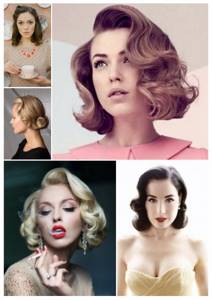
Part of the hair is separated by a horizontal parting. Next, this hair is wound in parts onto a curling iron, while the resulting curl does not need to be unraveled, but should be secured with an invisible ring to the head. Next, another parting is created and the curls are curled in the same way. When everything is ready, and the hair has already cooled down after the curling iron, you can remove the bobby pins at the bottom of the head and comb the strands a little. Then they should be gathered into a bun and carefully fixed at the bottom of the head. The same is done with the middle part. But the curls at the top are freed from bobby pins and laid out on both sides of the head. Everything is fixed with a special product that preserves the hairstyle.
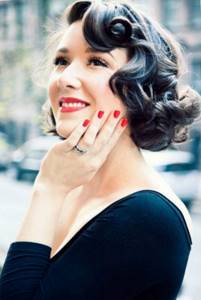
This hairstyle was worn by the great Marilyn Monroe, who was distinguished by her grace, femininity and style, which is why the hairstyle has such a name. Every girl who tries on this look can feel fashionable and perfect.
Dude style ponytail
But this “stylish” hairstyle is perfect for long hair.
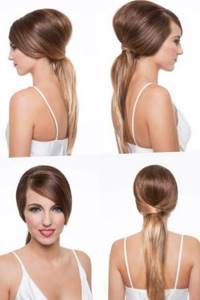
This style is based on a regular ponytail, which is created at the top or bottom from the lower strands. The front hair is combed, and the resulting curls are laid on top of the tail. Here everything depends on the imagination of the creator. It would also be great to pair it with a ribbon.
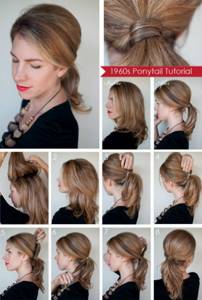
You can style your ponytail in a retro style in different ways.
Flying high
This styling has several variations, but the principle of creation is the same. To begin with, the hair at the back of the head is combed to give it a full look. The upper strands should carefully cover the backcomb. Strands are taken from the sides and pinned crosswise at the back. The ends of your hair can be curled a little.
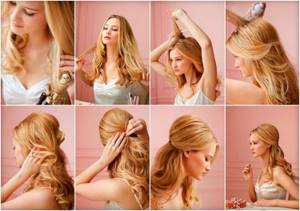
With bangs, such a retro hairstyle will look no worse.
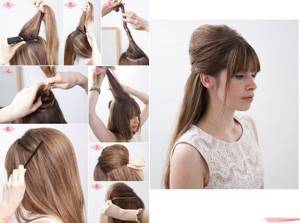
When creating this look, you can avoid pinning the strands at the back of your head, but simply backcomb it and use a ribbon, headband, or bright comb clip.
Babette
Well, of course, we associate the babette hairstyle with retro fashion, although it is now very often used by business ladies.
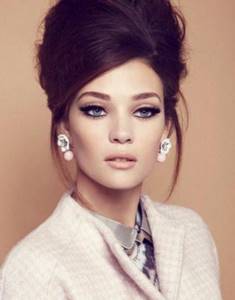
The hair is cut horizontally into two parts. The top one is removed for a while, and the bottom one is backcombed. It should be rolled up. A small backcomb is also done in the upper part, and this part of the hair lies on top of the roller.
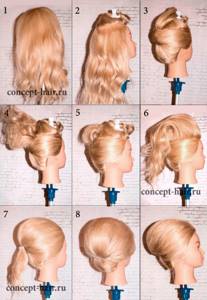
The babette with a ribbon looks beautiful. It can be created in a slightly different way. A step-by-step photo will demonstrate how to create an image with this accessory.
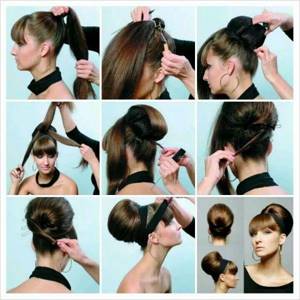
Choose the color of the ribbon so that the hairstyle as a whole looks harmonious with the dress.
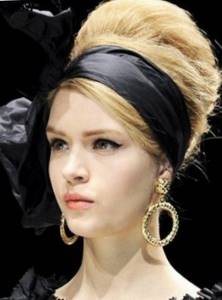
Bun
This installation is done very quickly, and the result is simply amazing. Hair is combed. The bangs are pulled to the side, it can be twisted a little, and the rest of the hair is collected in a ponytail, from which you should create a beautiful and even bun at the top of the head using a donut. All protruding hairs are removed using hairpins. You can also complement the look with a ribbon or scarf.
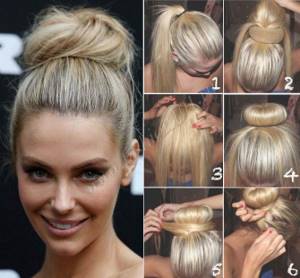
For a modern twist, you can make a hair bow instead of a bun; the hairstyle will look original and unusual.
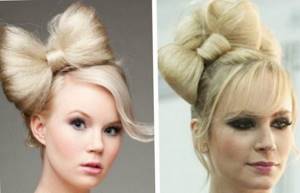
Dude hairstyle for short hair
This hairstyle, similar to that of dudes, can be created on medium-length hair.

To begin with, the entire hair is curled with a curling iron or curlers, so that only a few centimeters at the roots remain uncurled. Volume is then created at the root. Everything is fixed with varnish.
If you get a little more creative, you can lay all your curls on one side, which will create a stylish asymmetrical hairstyle done on one side.
For short hair, you can also perform the above-described dude hairstyle called “high flying.” A step-by-step photo will show you the entire process of creating a styling.

Short hair is not an obstacle to creating a babette. How to make it on a short length? See step by step photo.
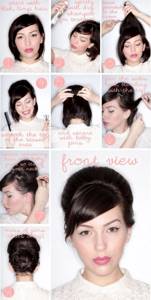
Hipsters in the USSR
The name “hip” became a household word thanks to the famous feuilleton of the same name by D. Belyaev, published in the magazine “Crocodile” under the heading “Types that are a thing of the past.”
The etymology of the nickname term “hip” indicates its connection with the concept of style. “To style” originally meant to perform (music, dance) in someone else’s style. A different style began to appear in clothing, appearance, communication and behavior.
Let’s try to describe the “classic” dude and compare the textbook-famous image with its Siberian variation. Along the avenue, like a mannequin, in the evening, a spectacular gentleman wanders. The loafer and the gentleman will give you everything for a colorful, stylish tie and for rubber.
Specific clothing was the main characteristic of dudes. A relatively small layer of people in unusual clothes could not help but stand out against the general background of modestly standardly dressed citizens.
It should be noted that the appearance of the dudes changed: from the caricature dressed in wide-baggy clothes of unimaginable colors in the second half of the 1940s - through the pipe trousers of the 1950s - to the elegance of the "shtatniks" (dressed in branded American things) and the refusal to obvious shocking during the years of Khrushchev’s “thaw”. According to the KGB, in Moscow in the late 1950s it was already difficult to distinguish dudes from foreigners, since loudness and flashiness had gone from the image, and the ability to dress stylishly had come.
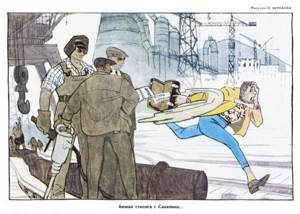
In the provinces, the evolution of the image is less pronounced. Even the metropolitan dudes experienced enormous difficulties in acquiring things that created the desired image, especially branded ones. On the Siberian periphery, there was no such layer of “golden youth” and black marketeers in those years; fashion arrived here several years late. For the bulk of Siberian dudes, the problem of purchasing imported clothing was practically insoluble. “Hipsters are mainly students, as the more educated part of the population, mainly from wealthy families. Since clothes - the main difference - were quite expensive. It was obtained from those who had been abroad. Partially imported clothes were obtained in ports. In our (Krasnoyarsk - S.R.) region - this is Igarka, where foreign ships came for timber. Student construction teams set out for loading. They brought cigarettes, colored shirts, and checkered jackets. But this, so to speak, is the elite of the movement... The rest of the population made do with Soviet consumer goods and flea markets.” In addition, branded clothing with labels was not defiantly alternative, as required by the image of a dude, most of whom had not reached the level of a “staff worker.” Therefore, other sources of means of self-expression were required. One of the possible options was to turn to private tailors and shoemakers. The activities of private artisans were under the close attention of many authorities, and in the early sixties, according to the plans of the leadership of the party and the country, they should have come to nothing. Sewing at home for commercial purposes was equated to speculation and threatened with imprisonment from 5 to 10 years (Article 107 of the Criminal Code of the RSFSR)4. It was all the more risky to sheathe dudes. But the underground production of clothes and shoes was a very profitable business for them. Using Siberian material, we were able to record facts of illegal appeal of dudes to masters of custom tailoring.
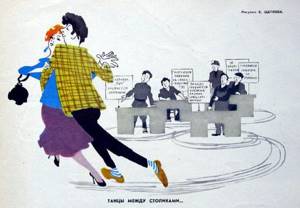
“In 1951, I moved to Krasnoyarsk, where I worked in an atelier... Among the orders there were those that did not quite correspond to the model of a decent citizen. One of these customers was a girl, her name was Renata E. She appeared to be either a stylish girl, or, as they usually do, a chick. She comes from a wealthy family, her father is a doctor, her mother is an engineer, but apparently she lacked extreme sports or something? Our acquaintance was arranged by a woman who worked with me. Renata came to her with a request to sew outfits, she refused for fear that everything would be found out and she might be arrested. Sewing stylish items was prohibited, because the style did not correspond to our structure. I, being a provincial girl, agreed, since the work offered a large salary for that time. If an ordinary suit cost about 80-100 rubles, then a style order cost more than a hundred rubles, and the profit went to the master. I was engaged in tailoring underground, sewing for Renate at my home.” However, the most common source for creating the proper image of a dude, especially in the provinces, was the famous “samostrok”. With one’s own hand or with the help of a home-grown “specialist”, from improvised materials or alterations from “sovparshiv”, at the cost of incredible efforts, the desired features of a stylish image were created.
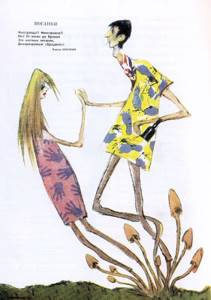
“I like to remember about my younger brother, he was fashionable, or as they used to say, “fashionable”: he sewed in his trousers and then, to put them on, he soaped his legs... But dad was strict in this regard, and Petya brought his things in order the state in which they were originally”; “We started looking for these (tight - CP) trousers, then we realized that we had to sew them ourselves. We started looking for bright shirts, which was very difficult, and in fact there were only one or two such shirts, and the number was gone...” The dudes’ shoes were also not like “everyone else.” For the manufacture of boots weighing up to 2.5 kg, according to Alexei Kozlov, the capital's dudes paid 500 rubles. It’s not a fact that there were the right shoemakers, and few could pay a lot of money for “semolina porridge,” as these boots were figuratively called for their light-colored, porous soles. Therefore, dudes had to show incredible ingenuity in attaching a corrugated platform or multi-layer rubber to ordinary Soviet-made shoes. The typical dude remained in the mass consciousness, including Siberians, dressed in short, tapered pipe trousers, the width of which at the bottom was 21-22 cm (but some especially stylish ones brought it up to 18 cm) and bright shirts. On the feet are low shoes with thick white and yellow rubber soles or shoes with tapered toes. Respondents also name checkered jackets, brimmed hats, and dark glasses as stylish accessories. But there were few happy owners of these attributes in Siberia. Mention of ties of the “fire in the jungle” type (with images of monkeys, palm trees and other exotic things) was found only once, in the memoirs of an “elite” dude. And his fellow countrymen were content mainly with thin “herring” and “lace” ties, often made independently. Stylishly dressed girls were found mainly in capital cities. The German magazine Der Spiegel wrote in 1962: “Just a few years ago, a Russian girl of adulthood looked like this: a crown of braids on her head, a waist-length dress and heavy shoes. Whether in a ballroom or at a May Day demonstration... This ideal is no longer indisputable... The young ladies who populate Moscow cafes in the evenings are almost no different in the cut of their dresses and hairstyles from the girls of their age in Berlin, Paris and Rome.”8. In the provinces, few representatives of the fair sex dared to experiment boldly with their appearance. Mostly the most desperate girlfriends of stylish guys. In relation to girls, the norms of public morality were more severe. It was enough to wear a skirt just above the knee, hug your hips, and use makeup to be considered a dude.
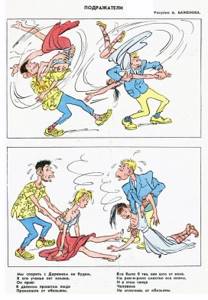
The former stylish girl recalls: “It was hard with my mother - an unloved daughter and a lot of bickering and complaints about each other - I couldn’t dress or look really good. I finished tenth grade in Moscow - I ran away from my parents to the big city. She studied in the same class with Marianna Vertinskaya. She sewed clothes herself and bought them “through connections.” I was especially faced with what to wear in Moscow. I took the boots that I brought with me from Siberia, cut off the shanks from them, and 17 cm was enough for me to wear a miniskirt. You can't sit down or get on the bus. But there is something to remember. They stopped wearing bras then.” It is significant that in her hometown she did not find freedom for self-expression and, in search of a beautiful life, she fled from Stalinsk (now Novokuznetsk) in the Kemerovo region to Moscow.
Hey boy, boy!
He screwed up the Danish cook.
I couldn't figure it out:
Is he a lady or a boy!
The dude's alternative hairstyle also made him stand out from the crowd. While the officially accepted men's haircuts were “boxing” and “half-boxing” with a shaved nape, dudes grew long hair “like Tarzan”, put a “cock” on their heads, greasing and beating it, and, for greater persuasiveness, fixing it with sugar syrup .
From the facial hair, “bastards” mustaches were released or glued on. The female version of the stylish hairstyle was “Babette” - high-lifted varnished hair, like the French sex symbol Brigitte Bardot in the film “Babette Goes to War”. Classic “cocas” on Siberian material are quite rare, and we were not able to find any mention of “bastards” at all. Basically, local dudes limited themselves to growing their hair “above the established standard” and combing their forelocks. Of the haircuts, the most often called “Canadian”.
In addition to the “babette”, also mentioned as stylish women’s hairstyle options are comb-overs, short haircuts in the French style and with bangs, “world crowns”... that is, almost everything that was an alternative to traditional braids.
He was Grisha, but now
Named Harry...
Every day at the usual time
Harry is on the boulevard.
In every major city, the dudes had special gathering places. They called them “Brody” (from “Broadway”): Gorky Street and Pushkin Square in Moscow, Nevsky Prospekt in Leningrad, Kuibyshevskaya Street in Samara, Deribasovskaya in Odessa. Siberia also had its own Brody. For example, in Krasnoyarsk - on Mira Avenue (former Stalin Avenue), from Dzerzhinsky Street (!) to Perenson Street.
It is significant that the central streets and squares of cities became Brody, which emphasized the demonstrative nature of involvement in the dude community. But most often the places where style was demonstrated in the provinces were parks and dance floors.
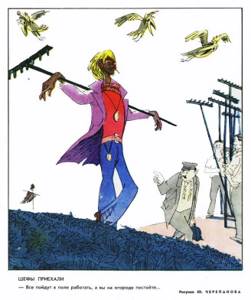
The hipster turns to the record store salesman: “I asked you for boogie-woogie, and you gave me Bach fugues!”
Special musical and dance preferences are also considered a characteristic feature of styling. The dudes listened to “non-Soviet” jazz and saxophonic music. Since jazz is a melodic style based on improvisation, it “became something more than music, it acquired the features of ideology, or rather, anti-ideology.”
Their idols were Glenn Miller, Duke Ellington, Benny Goodman. It was from the dudes that the tradition of underground sound recording began, popularly called “music on bones,” “music on ribs,” or “my grandmother’s skeleton.” Such records were illegally cut into X-rays by workers at recording studios or by craftsmen at home. The quality of the recordings was, as a rule, terrible, and they were much more expensive than the real ones. Later, reel-to-reel tape recorders began to appear, but in Siberian cities even in the 1960s they were very rare, so magnetic recordings were not a significant channel for the penetration of “style” music. Much more often in our archive of memories we find information about listening to music programs from foreign radio stations. In general, at the provincial level, the connection between dudes and jazz turned out to be less close than in the classical version of ideas about this subculture. But on the dance floors, the Siberian dudes were perhaps not inferior to their metropolitan counterparts, despite the vigilant control of the organizers of mass cultural events. The approved programs of dance evenings included waltzes, foxtrots, and polkas. The rules of the routine strictly stated: “At dance evenings it is not allowed... to dance in any kind of “styles” and to distort the existing edition of dances... to violate the established position of the partners’ hands when performing dances. Persons violating these rules will be removed from... the dances.” But despite all the dire warnings and measures to suppress “alien” dance steps, it turned out to be impossible to eradicate them. The most popular dude dances were boogie-woogie and rock and roll. The dudes themselves recall: “And how we danced rock and roll, Charleston, twist, waltz, tango in the club on Saturdays! In general, it was great!” Although they admit: “They danced boogie-woogie, later twist... They didn’t know the correct movements, they danced as best they could.”
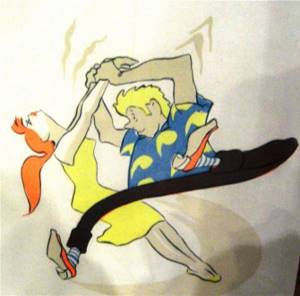
The public's reaction was mixed... “Before that we danced waltzes, polkas, krakowiaks and others, but now this! They (the dudes - R.S.) danced very unusually. Their movements were very interesting. We couldn’t do that, and we didn’t strive to do that. For us it was all just cheesy. We danced in a simple, modest way.” The dudes, in the language of one of our informants, “kicked off at the dances, danced not our way... All the boys were like boys, and they stood out against the general background like “white crows.” So we raised them, we even beat them at dances.” He's a fashionable dude, he's hungry, his pants are tight, he's not Russian!
The dudes also had their own slang - a special language of communication. Partially, everyday words were remade in a foreign manner (father - phaser, look - lyuk, drink - drink, money - manyushki, walk - throw break, boots - shoes), as well as proper names (Fedya-Fred, Misha-Michael, Grisha -Harry). But the stock of foreign words was clearly not enough, so slang words were also used. The dudes called themselves “dudes” and “dudes”, their apartments for parties were “huts”, “promoting” meant escaping from a gentleman, etc.
In the Siberian material, Americanisms are less common, and other slang words were used quite actively, going far beyond the relatively narrow circle of dudes and spreading mainly among young people. There, admiring himself, he stood up, gazing at the girls. He hasn’t read a book for a long time, and hasn’t been to museums. Among the behavioral differences of the classic image of dudes, impressiveness, articulate walking along the Broad, purring jazz melodies, pronouncing words with a special intonation (nasally, “on the nose”), and even a special look are usually dominant.
In our archive of memories, the listed signs, except for a special gait, are practically not found. Perhaps they are hidden behind more general characteristics, such as cheeky behavior, rudeness, deliberately attracting increased attention to oneself. “In my opinion, they differed from ordinary working people in their loudness. I can also note their attitude towards others: they behaved dismissively, sneezed at everyone, they saw only themselves. And they received the same attitude from the people”; “I didn’t like such young people, because I thought their clothing style was too vulgar and not at all attractive, and their cheeky, boorish behavior”;
“I didn’t treat the dudes very well, because they stood out from the general mass of people: they had polos and hats. I didn’t envy them; on the contrary, I was happy for people who achieved something in this life. But they felt special, I thought so.” I won't fall under the dude!
Hipsters are considered the harbingers or pioneers of the “sexual revolution” in the country. Perhaps there was some frivolity in relations between representatives of the opposite sexes. But, firstly, it was rather the “secret” that became more obvious. And, secondly, ideas about the debauchery of local dudes are, to say the least, exaggerated. For Soviet citizens brought up in the spirit of chastity, even hugs on the streets seemed indecent, but the dudes, according to ordinary people, “had freedom in behavior, relaxedness, young people allowed free love - kisses on the streets, hugs.”
The collective image of a dude turned out to be very conventional. On the one hand, there was a very thin layer of “elite”, especially in the provinces, equipped in the latest fashion, and on the other hand, there were a lot of imitators operating using the “remake-remake” method. Therefore, the range of stylish “portraits” is amazingly wide: from dandyism, close to the level of “staff workers”, to inept handicraft copying of vaguely imagined attributes: “At that time I considered myself a dude. Since 1957, he dressed only in the latest youth fashion. The atelier sewed me tight trousers with a 6 cm welt, shirts and jackets were brought from the GDR, Czechoslovakian shoes, ties with exotic designs, sometimes with naked women, from Italy. All things were acquired in various ways: through connections, at a flea market, for exchange, orders were placed for the lucky ones leaving overseas... And what music we had! After Khrushchev's warming, military 4-track tape recorders appeared - and this is foreign music... In 1961, I bought a MAG-56 tape recorder for 370 rubles, 4-track, with automatic track switching, three-speed, a former “military eavesdropper”, with tape for two hours of continuous recording. It happened that I was looking for a cracker lying around in the nightstand. And I had to sit in the Leningrad “Astoria”... and in the Moscow mirror “Prague”. Yes, I was a dude, at least we thought so, at least we tried to be like them. It all started when someone, and I don’t remember who exactly, went to Tomsk and there he saw a man in tight trousers and a jacket with a bright red shirt. When I came back, I told my friends about it. In general, it was difficult for us to follow the fashion of the dudes, we just somehow didn’t live close to Tomsk... And in the city a couple of times I talked to them (the dudes - S.R.), of course, they were more fashionable, and we envied them ..." “At that time there was a fashion for short, skinny trousers, and my older brother Valery decided to make himself some from a suit that they bought him for school. He sewed them in as best he could, shortened them and ironed them. I tried to put it on, but it didn’t work. He called me, and the two of us somehow pulled these trousers on him. Valera walked around, looked and was very pleased. The two of them also took off their trousers. My parents saw the “modernized” trousers when we were already getting ready for school on September 1st. It was already too late to do anything. The brother came home dissatisfied and ripped his trousers. He said that at school his classmates ridiculed him and asked why he was wearing riding breeches and not boots. Due to his inexperience, he sewed in his trousers only from the knees.” These “hipsters” were so different. But overall, their Siberian counterparts turned out to bear little resemblance to their romanticized and mythologized stereotype. In addition, during the study we encountered a broader interpretation of this term-name. The everyday consciousness of many representatives of the older generation of Siberians did not draw a sharp line between the dudes and representatives of later youth movements.
Often, dudes were called everyone who stands out in some way, “force,” regardless of whether he is dressed in “pipes,” bell-bottoms, or jeans; listens to jazz or rock; dances a twist or shake; a tuft on his head or loose long hair. In the typical image: “Pipes, checkered trousers, boots with thick soles, hairstyles, greased upright, dancing in style - some kind of boogie-woogie,” a purely attributive assessment prevails: specific pretentious clothing and dancing in style. Special musical interests and pronounced behavioral differences are mentioned much less frequently. A hipster is, first of all, an “upstart”, “one who stands out from the crowd”, a “dude”, “not like all normal guys”, less often - a “player of life”.
Dudes style hairstyle for girls
Girls can use the same dude hairstyles as adults.
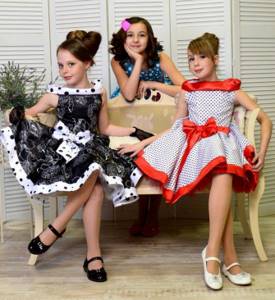
Just don’t use too much varnish, and you should also make sure that the child is comfortable.
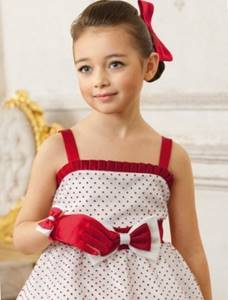
For example, the babette, which was previously described, is also perfect as a dudes hairstyle for girls.
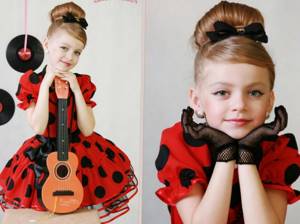
You can make it with a headband or some other decorations. This option is perfect for graduation from kindergarten or school.
https://youtu.be/OSylpsAjn6A
High styling
This hairstyle can be done by both a little fashionista, a girl of 6-7 years old, and older girls. The hair is backcombed, then it is carefully collected at the top of the head and fixed. Next, you need to create a beautiful bun from them. You can use a special roller if your hair is not very thick.
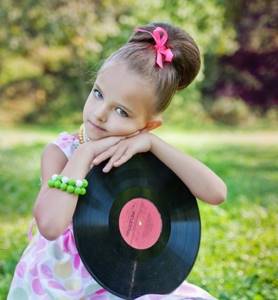
Dude's hairstyle for children
Dude's children's hairstyles are very diverse, resulting in interesting, bright and memorable images.

Let's consider one of their types for a girl.
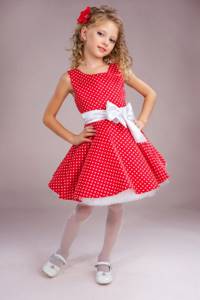
The hair is divided horizontally into two parts. A tail is tied from the bottom. Using a special roller, a bun is created at the back from the tail, which has been tied. Next, a mesh is created from the top of the hair. A net is not a braid, but hair gathered on all sides into a net using elastic bands. Multi-colored rubber bands are perfect for a bright, stylish look. An example of such a grid can be seen in the photo, but it may have a different appearance.
The ends of the mesh can be hidden, or you can wind it and leave it hanging over the roller.
A bun for children can also be decorated with braiding and ribbon.
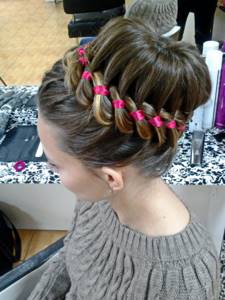
An interesting way to style a child's retro hairstyle is to use a roller on the side. The hair can be pinned back with bobby pins or left loose.
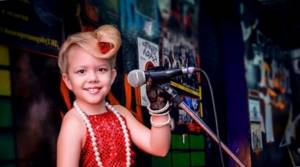
Prom hairstyles in dude style
At prom, a dude-style hairstyle will look great under a dress and will definitely make the girl stand out from the rest.
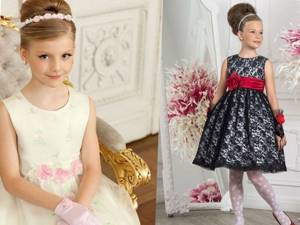
For example, you can do a hairstyle like a puffy ponytail; it’s perfect for a special event, and it’s not at all difficult to do.
All the hair is collected high in a ponytail. The hair in the ponytail becomes combed. Next, take a small strand from the tail; in order to cover the elastic band, you need to carefully wrap it around the base of the tail. The hair of the tail is curled onto a curling iron.
Style features
Representatives of the subculture had a specific appearance, special manners of behavior, their own slang and musical preferences. In many ways, the preferences of the dudes were shaped by “trophy” films - “A Soldier’s Fate in America”, “Sun Valley Serenade”, “Tarzan”, “The Girl of My Dreams”, “George from Dinky Jazz”, as well as films with Dinah Durbin.
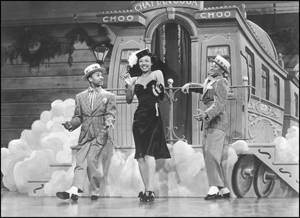
Cloth
The first dudes wore baggy double-breasted jackets of colorful colors, wide-brimmed hats, bright socks peeking out from under their trousers, colored silk or Hawaiian shirts, sweaters with deer, pointed high-soled boots, ties with dragons, monkeys, and roosters.
Later, the attire of the representatives of the subculture became more elegant: trousers with a width of 22 cm - as opposed to the Soviet 32 cm, jeans, cane umbrellas, narrow herring ties.
By the 60s, in honor of following American fashion, dudes began to call themselves “staff workers.” By that time, formal raincoats with a top button, ratin coats in the English style, pure wool suits, wide gray jackets with a handkerchief in the pocket, tailor-made Stetson hats, American soldier boots and shoes with perforated toes were popular among representatives of the movement.
The men's wardrobe became the quintessence of the protest movement - stylish girls did not have their own style. They copied styles from Baltic or socialist fashion magazines: they wore fluffy and tight skirts, trousers, bright blouses with floral prints, and shoes with long toes.
Wealthy dudes bought clothes from black marketeers or visiting foreigners, and also ordered clothes made from Western fabrics purchased in thrift stores. Hipsters from poor families often sewed raincoats and trousers from canvas, stuck so-called “semolina porridge” on their shoes - soles made of rubber or microporous, which were then corrugated on the sides, etc. Representatives of the subculture held special “luxury items” in high esteem - foreign fountain pens , cigarette cases and lighters, as well as American playing cards with girls in Pin-up style.
Hair and makeup
Hipsters of the 50s wore combed and greased “cocks” on their foreheads, as well as a thin “bastard” mustache.
Hipster girls used more cosmetics than ordinary Soviet women. Bright lipstick and thickly lined eyes were welcomed. A fashionable hairstyle was the “crown of peace”, for which the hair was curled and styled around the head, and by the 60s, thanks to the film “Babette Goes to War” with Brigitte Bardot, the combed babette, worn by the main character of the film, became incredibly popular.
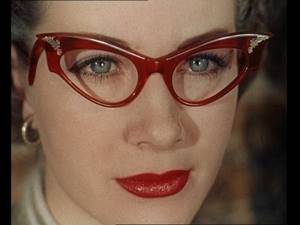
Manners
“In the most fashionable jacket, with an indifferent look, a dandy with a ring on his hand walks like a capital lion...” B. Timofeev
The dudes had special manners of movement, which in Belyaev’s feuilleton were presented as “extraordinarily cheeky.” The plasticity of the representatives of the subculture was conscious and thoughtful: a high head and a free gait indicated that they belonged to the movement, in addition, it was dictated by costume and dancing. Hipsters from different cities in the evenings walked (“made a heel”) along “Broadway” - usually the main street of the city (Gorky Street in Moscow, Nevsky Prospekt in Leningrad). An important element of such walks was the demonstration of their costumes.
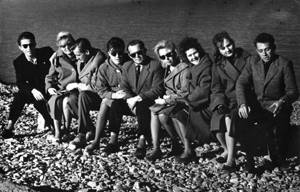
Slang
“He was Grisha, but now he goes by the name Harry. Every day at the usual hour Harry is on the boulevard.” B. Timofeev
The special slang of the dudes consisted of English borrowings, reinterpreted in the Russian way, combined with elements of musical jargon. Also, dudes changed their names to foreign ones that sounded like them.
Jacket (English jacket) - jacket.
Sovparshiv - clothes and shoes made in the Soviet Union or homemade.
Socks are bright socks visible from under the trouser leg.
Taek (English tie) - tie.
Truzer , trauser , trauzers (English trousers) - trousers.
Trench coat (eng. trenchcoat) - raincoat
Hatok (English hat) - hat.
Shoes , shuznya (English shoes) - boots with high soles.
Music
The main attribute of the dudes was the saxophone, which personified the music of free people. The dudes were fond of foreign dances and music - primarily jazz.
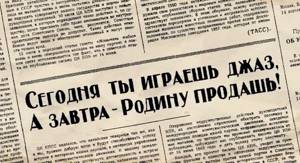
Dudes hairstyle for a boy
A hairstyle called “dudes” can be used not only for girls, but boys can also try on this look.
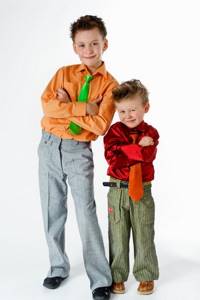
Here the basis is made up of curls raised high and fixed with varnish; it is best to do a similar styling if the child has medium length hair and has bangs. Your head should be a little messy.
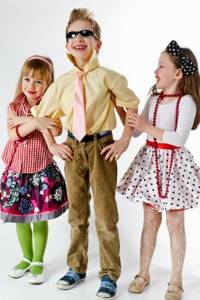
A boy can try on this hairstyle for some holiday, or even for graduation, both for kindergarten and school.
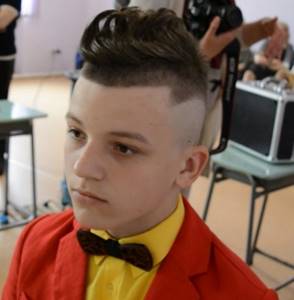
Do not forget that the clothes must match the hairstyle, otherwise it will not be harmonious and there will be no overall image.
Men's hairstyle dudes
A men's hairstyle like a dude can be created quickly enough and it is not necessary to resort to the help of a specialist.

Cook
The hair is washed well and mousse is applied to the damp, but not completely wet hair, which should be distributed over the entire length. The hair near the forehead is dried with a round comb; it should be dried by lifting it up. Next, everything needs to be varnished very well.

Of course, now there is hardly a man who uses such an image every day, but to try it on for some thematic event would be very cool, and in general for a celebration with friends it would also turn out to be very cool and interesting.

But, if you make your styling a little calmer, then you can be in the style of a dude on ordinary weekdays, and you can be sure that all the attention will be only on you. So, when choosing this look, you need to be ready to shine.
See a wide variety of retro hairstyles here.
Features inherent in this dress
The most “common” style of dress in the dude style is considered to be a tight-fitting bust plus a circle skirt. And there are a great many variations based on this “template”. The main details that distinguish the model of this genre from others:
- wide flared, circle or peplum skirt with a narrow pencil skirt;
- the length is NOT short, optimally - slightly above or slightly below the knees;
- bright fabric - satin, brocade, satin, silk, chiffon, etc.;
- prints - polka dots, checkered patterns, large or small flowers, geometric patterns, etc.;
- contrasting materials (two or three, one main, the other finishing);
- belt, bow, straps and other large details.
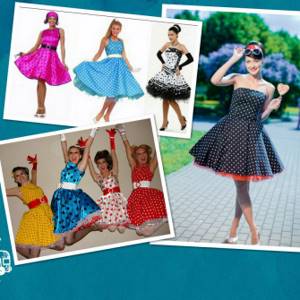
How to complement the dress?
Styling a look is a lot of work, and one dress will not be enough. However, this approach is recommended for any fashion genre, isn’t it? However, everything here must be absolutely flawless! So, what to add to a dudes style dress?
Makeup
It should be bright and durable. Classically, this can be long arrows, beige or soft pink shadows, plus bright pink or red lipstick. However, the latter can be replaced with a lip gloss that is “comfortable” for you. The main thing is “not to go out” without lipstick at all.
Choose an even skin color and delicate blush in accordance with your color type. And remember the most important rule: “do not overload” your face with bright details, the emphasis is on the eyes and lips.
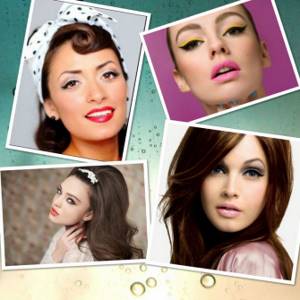
Shoes
What to choose – a comfortable wedge or a heel? High block or low? Bright materials or not? Here the choice should “fall” solely depending on the image. Lacquer and leather are style favorites, but fabric models are also allowed. The most suitable models for the style genre:
- "without a small nose"
- High platform
- Pointed nose+closed ankle
- Neat platform and high narrow heel
- Shoes with a jumper in the middle
- Classic pumps
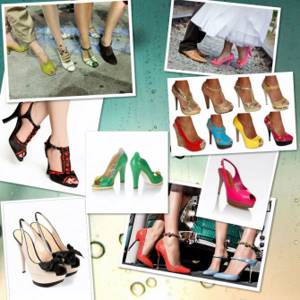
Hairstyle
You can comb your hair smoothly back, straighten it and tie it with a satin ribbon. But we’re not looking for easy ways, are we? High babette, bouffant, and sophisticated retro hairstyles suit this style perfectly. But just loose hair with a flower pinned on the top or side of the head will be “in style.” Let's look:
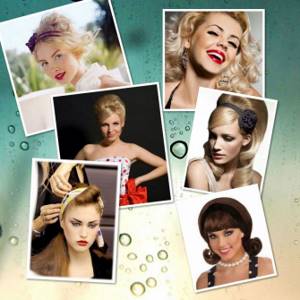
Accessories
Bag
. A small handbag will go wonderfully with a dude style dress, as will a retro reticule, a theatrical model with a short strap, and even a clutch. The main feature here is color: the handbag should be bright. Any rich colors are allowed.
Glasses
. Elongated models that cannot be confused with any others are a feature of the style. If you want to add some zest to your look, be sure to pay attention to glasses.
Bijouterie
. Large beads are an indispensable attribute of a stylish look, which you must have with your dress. Choose “to match” its tint color, but this is not necessary.
Belt
. Wide varnish belt or bow - as you wish. The main thing is that it matches the style of the dress.
And don't forget the gloves! Bright patent leather up to the elbows - they will be a great addition to your outfit.
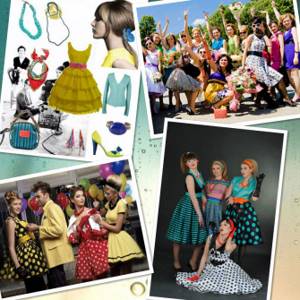
How to choose a dude style dress to suit your figure?
Of course, you need to approach the choice of such an outfit “wisely”. How to hide certain imperfections with the help of such a dress? Let's look at the most common of them.
Small breasts
If you suffer from having a small bust, a stylish dress will help you make your figure more proportional! In the bust area, it is necessary to make a “square” deep neckline or yoke, and the skirt must be wide in order to emphasize the thin waist, which, in turn, will emphasize the bust. It's simple!
Wide hips
A flared skirt is the perfect disguise for such a disadvantage. Feel free to wear it, and don’t forget about the accessories! By the way, it is recommended to make the bodice simple, without any “overload” of details.
Full legs
A skirt just below the knees will help disguise this flaw. Its length should be just up to the place that is “narrowest” under the knee. This visually makes your legs slimmer, verified! And the shoes must have heels (platforms are cancelled!).
Full hands
Choose a dress with long sleeves, ¾ length or slightly flared towards the wrist. It would be ideal to include lace in the cuffs.
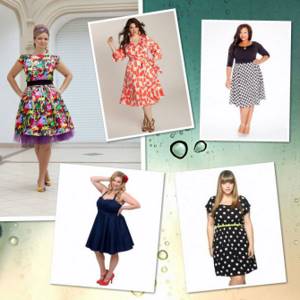
Which dude style dress to choose for prom?
Of course, it will be great if the theme of the ball is close to retro. But if you simply like this genre, don’t be shy about looking brighter than others; when will you be able to dress like that in the future? And if you dress up in this fun style with your boyfriend, you'll make a mind-blowing couple that will rock the holidays.
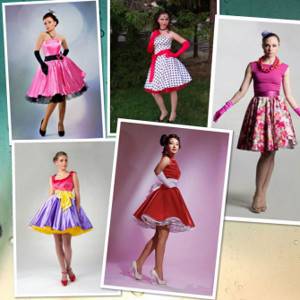
And most importantly, don’t forget a good mood! Without it, this style “doesn’t look good.”

